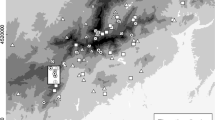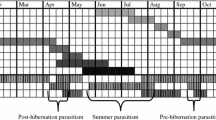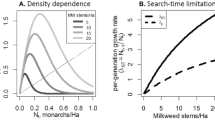Abstract
The lycaenid butterfly, Maculinea rebeli, and its specialist parasitoid, Ichneumon eumerus, live in small, closed populations. Given the threatened status of the butterfly, it is reasonable to assume that its specialist parasitoid is even more vulnerable to local extinction than the butterfly host. Based on a mechanistic model recently developed for the tightly-woven community surrounding M. rebeli at a site in the Spanish Pyrenees, we investigate how the removal of habitat, and more particularly, specific habitat promoting the persistence of the butterfly, affects the population persistence of the parasitoid. Because of the relatively small impact of the parasitoid on the butterfly population in the Spanish Pyrenees, guidelines for conserving the parasitoid are only slightly more restrictive than those for its host. It is argued that at sites of more marginal quality for the butterfly than the reference site, achieving the dual aims of conserving both species will be more problematic. © Rapid Science Ltd. 1998
Similar content being viewed by others
References
Brian, M.V. (1965) Social Insect Populations. London: Academic Press.
Elmes, G.W., Thomas, J.A. and Wardlaw, J.C. (1991a) Larvae of Maculinea rebeli, a large-blue butterfly, and their Myrmica host ants: wild adoption and behaviour in ant nests. J. Zool. (London) 223, 447–60.
Elmes, G.W., Wardlaw, J.C. and Thomas, J.A. (1991b) Larvae of Maculinea rebeli, a large-blue butterfly, and their Myrmica host ants: patterns of caterpillar growth and survival. J. Zool. (London) 224, 79–92.
Elmes, G.W., Clarke, R.T., Thomas, J.A. and Hochberg, M.E. (1996) Empirical tests of specific predictions made from a spatial model of the population dynamics of Maculinea rebeli, a parasitic butterfly of red ant colonies. Acta Oecologica 17, 61–80.
Gilpin, M.E. and Hanski, I. (eds) (1991) Metapopulation dynamics: empirical and theoretical investigations. London: Academic Press.
Hawkins, B.A. (1994) Pattern and process in host–parasitoid interactions. Cambridge: Cambridge University Press.
Hochberg, M.E. (1996) An integrative paradigm of monophagous parasitoid dynamics. Oikos 77, 556–60.
Hochberg, M.E., Thomas, J.A. and Elmes, G.W. (1992) A modelling study of the population dynamics of a large blue butterfly, Maculinea rebeli, a parasite of red ant nests. J. Anim. Ecol. 61, 397–409.
Hochberg, M.E., Clarke, R.T., Elmes, G.W. and Thomas, J.A. (1994) Population dynamic consequences of direct and indirect interactions involving a large blue butterfly and its plant and red ant hosts. J. Anim. Ecol. 63, 375–91.
Hochberg, M.E., Elmes, G.W., Thomas, J.A. and Clarke, R.T. (1996) Mechanisms of local persistence in coupled host– parasitoid associations: the case model of Maculinea rebeli and Ichneumon eumerus. Phil. Trans. Royal Soc. Lond. B 351, 1713–24.
Holt, R.D. (1997) Community modules. In Multi-trophic interactions in terrestrial systems (A. Gange, ed.) pp. 333–50. Oxford: Blackwell.
Kockelke, K., Hermann, G., Kaule, G., Verhaagh, M. and Settele, J. (1994) Zur Autökologie und Verbreitung des Kreuzenzian-Ameisenbläulings, Maculinea rebeli (Hirschke 1904). Carolinea 53, 93–109.
Munguira, M.L. (1987) Biologia y biogeographia de los Lycénidos Ibéricos en peligro de extinciÒn (Lepidoptera, Lycaenidae). Tesis Doctoral Madrid.
Petal, J. (1967) Productivity and the consumption of food in the Myrmica laevinodis Nyl. population. In Secondary Productivity of Terrestrial Ecosytems (K. Petrusewicz, ed.) pp. 841–57.
Thomas, J.A. (1995) The ecology and conservation of Maculinea arion and other European species of large blue butterfly. In Ecology and Conservation of Butterflies (A.S. Pullin, ed.) pp. 180–97. London: Chapman and Hall.
Thomas, J.A. and Elmes, G.W. (1992) The ecology and conservation of Maculinea butterflies and their Ichneumon parasitoids. In Future of Butterflies in Europe 1989: Strategies for Survival (T. Pavlicek-van Beek, A.H. Ovaa and J.G. van der Made, eds) pp. 116–23. Wageningen: Agricultural University.
Thomas, J.A. and Elmes, G.W. (1993) Specialized searching and hostile use of allomones by a parasitoid whose host, the butterfly Maculinea rebeli, inhabits and nests. Anim. Behav. 45, 593–602.
Thomas, J.A., Elmes, G.W., Wardlaw, J.C. and Woyciechowski, M. (1989) Host specificity among Maculinea butterflies in Myrmica ant nests. Oecologia 79, 452–7.
Thomas, J.A., Elmes, G.W. and Wardlaw, J.C. (1993) Contest competition among Maculinea rebeli butterfly larvae in ant nests. Ecol. Entomol. 18, 73–6.
Wells, S.M., Pyle, R.M. and Collins, N.M. (1984) The IUCN Invertebrate Red Data Book. Gland: IUCN.
Author information
Authors and Affiliations
Rights and permissions
About this article
Cite this article
Hochberg, M.E., Elmes, G., Thomas, J. et al. Effects of habitat reduction on the persistence of Ichneumon eumerus (Hymenoptera: Ichneumonidae), the specialist parasitoid of Maculinea rebeli (Lepidoptera: Lycaenidae). Journal of Insect Conservation 2, 59–66 (1998). https://doi.org/10.1023/A:1009644807126
Issue Date:
DOI: https://doi.org/10.1023/A:1009644807126




